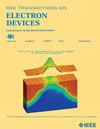具有增强导通能力的常关hemt型双极p-FET
IF 2.9
2区 工程技术
Q2 ENGINEERING, ELECTRICAL & ELECTRONIC
引用次数: 0
摘要
为了提高氮化镓基p沟道晶体管的传导电流密度,提出了一种常关闭hemm型双极p沟道场效应晶体管(nh - bipet)结构。在nh - bifet中,一个正常关闭的p-GaN栅极高电子迁移率晶体管(HEMT)与一个传统的p沟道场效应晶体管(p-FET)级联,利用电子作为主要载流子来大幅增强传导电流。结果,nh - bifet的漏极电流密度增加到43.91 mA/mm,大约是传统p-FET的34倍。此外,nh - bifet保持了与传统p- fet相当的高${I}_{\text {ON}}$ / ${I}_{\text {OFF}}$比率和低栅漏电流。然而,开关性能分析表明,p-GaN栅极和p-FET漏极之间的浮动节点放电速率较慢,可能导致关断瞬态时间延长。为了解决这个问题,进一步提出了由nhh - bipfet和一个额外的HEMT器件组成的增强型配置(eh - bipfet)。即使增加一个HEMT器件,基于enh - bipet的互补逻辑(CL)逆变器与传统的CL逆变器相比仍可节省43.8%的面积,同时保持相同的运行速度。本文章由计算机程序翻译,如有差异,请以英文原文为准。
Normally-Off HEMT-Based Bipolar p-FET With Enhanced Conduction Capability
A normally-OFF HEMT-based bipolar p-channel field-effect transistor (NH-BiPFET) structure is proposed to enlarge the conduction current density of GaN-based p-channel transistors. In the NH-BiPFET, a normally-OFF p-GaN gate high-electron-mobility transistor (HEMT) is cascaded with a conventional p-channel field-effect transistor (p-FET), leveraging electrons as majority carriers to enhance conduction current substantially. As a result, the drain current density in NH-BiPFET increases to 43.91 mA/mm, approximately 34 times higher than that of a conventional p-FET. Moreover, the NH-BiPFET maintains a high ${I}_{\text {ON}}$ / ${I}_{\text {OFF}}$ ratio and a low gate leakage current comparable to the conventional p-FETs. However, the analysis of switching performance reveals that the slow discharging rate of the floating node between the p-GaN gate and the p-FET drain can lead to a prolonged turn-off transient. To address this issue, an enhanced configuration (ENH-BiPFET) consisting of the NH-BiPFET and an additional HEMT device is further proposed. Even with one more HEMT device, the complementary logic (CL) inverter based on ENH-BiPFET can still save 43.8% area compared to the conventional CL inverters, while maintaining the same operation speed.
求助全文
通过发布文献求助,成功后即可免费获取论文全文。
去求助
来源期刊

IEEE Transactions on Electron Devices
工程技术-工程:电子与电气
CiteScore
5.80
自引率
16.10%
发文量
937
审稿时长
3.8 months
期刊介绍:
IEEE Transactions on Electron Devices publishes original and significant contributions relating to the theory, modeling, design, performance and reliability of electron and ion integrated circuit devices and interconnects, involving insulators, metals, organic materials, micro-plasmas, semiconductors, quantum-effect structures, vacuum devices, and emerging materials with applications in bioelectronics, biomedical electronics, computation, communications, displays, microelectromechanics, imaging, micro-actuators, nanoelectronics, optoelectronics, photovoltaics, power ICs and micro-sensors. Tutorial and review papers on these subjects are also published and occasional special issues appear to present a collection of papers which treat particular areas in more depth and breadth.
 求助内容:
求助内容: 应助结果提醒方式:
应助结果提醒方式:


